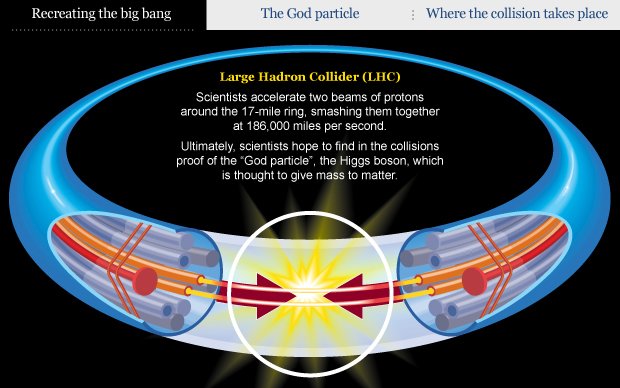Have you ever thought you'd be able to photograph a single atom with your dSLR camera? No? Neither thought we in One Bit News. What's the most interesting science related image you have seen?
It's incredible the captured atom, personally I never thought about that !!
I think the world is full of scientific images and videos, I will offer you a video that I find unimaginable.
According to an article I read about the subject after reading your post, the partiucule was held between two electrodes spaced only two millimeters, it could not afford to our eyes without the help of special conditions. Only a pressure several billion times lower than that of the atmosphere and an extremely low temperature made it possible to obtain this photo, winner of the grand prize of the photo competition organized by the Engineering and Physical Sciences Research Council.
Decrypting such a photo is a priori not easy. And yet, the game is worth the candle: in the center of the cliché hides an incredible element. Discreet but yet there, a tiny particle proudly sits in the middle of the image: a strontium atom.
If you look closer, you end up seeing it. A zoom on the photo can approach it, it sits among a weave of threads, connections and precision machined parts. These elements constitute the incredible device which made it possible to give birth to the cliché of this positively charged atom.
My contribution in the technology issue for this week is to propose a video about quantum physics that shows the behavior of particles in the presence of a measuring device. it's really amazing and leads us to think about the impact of this on our lives.
I've always found pictures of our DNA to be very interesting, I think I would like to learn more about it. But if it's like trying to understand atoms this might be a bit challenging. 💪
DNA is a molecule known to the general public and whose biologists and biochemists thought (almost) to know everything. Biologists have long shown that DNA is the carrier of genes, is passed down from generation to generation, and can also acquire mutations, which are at the origin of the evolution of species. Biochemists, meanwhile, are more interested in its structure, which allows DNA all its interactions with other biological molecules: proteins and RNA, whose interactions are necessary for life.
Fundamental bricks of the matter around us, atoms are everywhere around us. Consisting of a positively charged nucleus and negatively charged electrons, about 10-10 m in size, the atoms generally remain invisible to the naked eye. At least until now. Because it is the photograph of an atom that has emerged as the winner of the British Prize for Scientific Photography 2018, awarded by the Research Council in Engineering and Physical Sciences UK.
I think it would be the first picture NASA published of a planet that has the possibility for life. When they discovered the first earth size planet in a orbit similar to our planet. Still a long way to go to get there, but a major breakthrough.
Hi @Idigit,
We in onebitnews totally agree with you. The first picture of an exoplanet with confirmed bio-markers in it's spectrum would surpass all other scientific images. But until then, a single atom photographed with an old dSLR and a "Nifty-fifty lens" isn't bad. :)
Regards, @erlendgroseth
For @Onebitnews
In a press release from EPSRC, David Nadlinger explained the origin of the photo :
"The idea of being able to see a single atom with the naked eye seemed to me to be a marvelously direct and visceral bridge between the tiny quantum world and our macroscopic reality. A quick calculation showed me that the numbers were on my side, and when I moved into the lab with the camera and tripod on a quiet Sunday afternoon, I was rewarded with this special photo of a small and pale blue dot. "
One of the European Electron Laser and X-ray Laser tunnels, near Hamburg, Germany-European XFEL / AFP .
Heiner MULLER-ELSNER
The largest X-ray laser in the world, its ability to observe the infinitely small must allow for multidisciplinary scientific breakthroughs by dissecting the operation of atoms, viruses or chemical processes.
The exceptional character of the X-Ray Free Electron Laser European Laser (XFEL) can be summed up in one figure: 27,000 flashes per second. Compared to the 120 emitted by the American laser of the same type LCLS and the 60 generated by the SACLA in Japan.
this ultrafast rate should enable researchers to photograph "viruses at the atomic scale, decipher the molecular composition of cells, take three-dimensional images of the nanoworld, and study processes similar to those that occur at the same time. interior of the planets.
Når ein først byrjar å faktisk tenke gjennom kva ein faktisk ser her, så kan ein jo bli hovudgalen og middels tullerusk. Vi har kome ganske so langt når vi er i stand til å ta bilete av naturens minste byggjeklossar. Knalltøft, og litt skremmande på same tid.
Engineers perform a feat by storing information on a single atom !
IBM claims to have achieved a storage density a thousand times greater than traditional hard drives by offering a hard disk at the nanoscale that uses only one atom.
it’s very interesting as information, especially for me, I am a specialist in economics and I have minimal ideas on applied sciences.
but without forgetting to mention that the economy has a lot of relation with technology.
thank you @onebitnews for this post
CERN, the European Organization for Nuclear Research, physicists and engineers are probing the fundamental structure of the universe. They use the world's largest and most complex scientific instruments to study the basic constituents of matter – the fundamental particles.
It's incredible the captured atom, personally I never thought about that !!
I think the world is full of scientific images and videos, I will offer you a video that I find unimaginable.
According to an article I read about the subject after reading your post, the partiucule was held between two electrodes spaced only two millimeters, it could not afford to our eyes without the help of special conditions. Only a pressure several billion times lower than that of the atmosphere and an extremely low temperature made it possible to obtain this photo, winner of the grand prize of the photo competition organized by the Engineering and Physical Sciences Research Council.
Decrypting such a photo is a priori not easy. And yet, the game is worth the candle: in the center of the cliché hides an incredible element. Discreet but yet there, a tiny particle proudly sits in the middle of the image: a strontium atom.
If you look closer, you end up seeing it. A zoom on the photo can approach it, it sits among a weave of threads, connections and precision machined parts. These elements constitute the incredible device which made it possible to give birth to the cliché of this positively charged atom.
My contribution in the technology issue for this week is to propose a video about quantum physics that shows the behavior of particles in the presence of a measuring device. it's really amazing and leads us to think about the impact of this on our lives.
I've always found pictures of our DNA to be very interesting, I think I would like to learn more about it. But if it's like trying to understand atoms this might be a bit challenging. 💪
DNA is a molecule known to the general public and whose biologists and biochemists thought (almost) to know everything. Biologists have long shown that DNA is the carrier of genes, is passed down from generation to generation, and can also acquire mutations, which are at the origin of the evolution of species. Biochemists, meanwhile, are more interested in its structure, which allows DNA all its interactions with other biological molecules: proteins and RNA, whose interactions are necessary for life.
Fundamental bricks of the matter around us, atoms are everywhere around us. Consisting of a positively charged nucleus and negatively charged electrons, about 10-10 m in size, the atoms generally remain invisible to the naked eye. At least until now. Because it is the photograph of an atom that has emerged as the winner of the British Prize for Scientific Photography 2018, awarded by the Research Council in Engineering and Physical Sciences UK.
I think it would be the first picture NASA published of a planet that has the possibility for life. When they discovered the first earth size planet in a orbit similar to our planet. Still a long way to go to get there, but a major breakthrough.
( )
)
Hi @Idigit,
We in onebitnews totally agree with you. The first picture of an exoplanet with confirmed bio-markers in it's spectrum would surpass all other scientific images. But until then, a single atom photographed with an old dSLR and a "Nifty-fifty lens" isn't bad. :)
Regards, @erlendgroseth
For @Onebitnews
In a press release from EPSRC, David Nadlinger explained the origin of the photo :
One of the European Electron Laser and X-ray Laser tunnels, near Hamburg, Germany-European XFEL / AFP .
The largest X-ray laser in the world, its ability to observe the infinitely small must allow for multidisciplinary scientific breakthroughs by dissecting the operation of atoms, viruses or chemical processes.
The exceptional character of the X-Ray Free Electron Laser European Laser (XFEL) can be summed up in one figure: 27,000 flashes per second. Compared to the 120 emitted by the American laser of the same type LCLS and the 60 generated by the SACLA in Japan.
this ultrafast rate should enable researchers to photograph "viruses at the atomic scale, decipher the molecular composition of cells, take three-dimensional images of the nanoworld, and study processes similar to those that occur at the same time. interior of the planets.
Når ein først byrjar å faktisk tenke gjennom kva ein faktisk ser her, så kan ein jo bli hovudgalen og middels tullerusk. Vi har kome ganske so langt når vi er i stand til å ta bilete av naturens minste byggjeklossar. Knalltøft, og litt skremmande på same tid.

Engineers perform a feat by storing information on a single atom !
IBM claims to have achieved a storage density a thousand times greater than traditional hard drives by offering a hard disk at the nanoscale that uses only one atom.
it’s very interesting as information, especially for me, I am a specialist in economics and I have minimal ideas on applied sciences.
but without forgetting to mention that the economy has a lot of relation with technology.
thank you @onebitnews for this post
CERN, the European Organization for Nuclear Research, physicists and engineers are probing the fundamental structure of the universe. They use the world's largest and most complex scientific instruments to study the basic constituents of matter – the fundamental particles.
